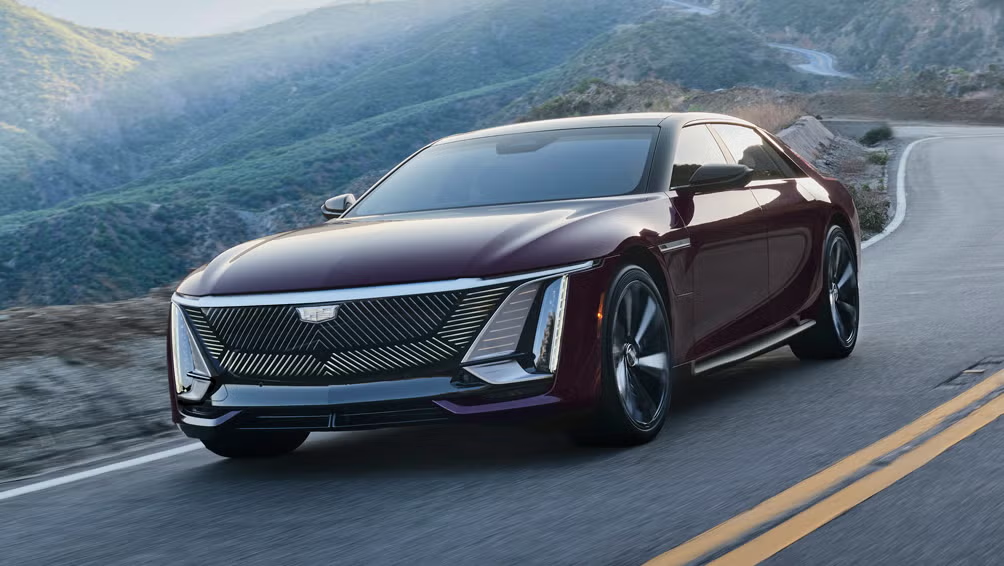As the pace of innovation accelerates, today’s vehicles are embracing electrification in more ways than just propulsion. It’s no longer only about performance figures, horsepower, or driving range—what’s inside the cabin is evolving just as rapidly.
For the average consumer, technological progress often translates to one obvious feature: larger touchscreens. And to a significant degree, that assumption holds true. There’s something inherently thrilling about having a full LED display right at your fingertips—but it begs the question: just how large will these screens become?
Judging by current trends, in-car touchscreens and infotainment systems are poised to continue growing in size. However, not everyone in the auto industry is convinced that this growth will persist indefinitely. BMW CEO Oliver Zipse has gone on record predicting that within the next decade, “the huge screens will be back under control.”
Whether it’s due to consumers recognizing that oversized screens aren’t essential, or regulators determining that they pose safety risks, BMW’s leadership appears confident that the era of ever-expanding screens is temporary.
It’s hard not to draw comparisons to the digital devices we use at home—where bigger usually means better. With that in mind, let’s explore a list of vehicles that currently feature LED displays and see just how large those screens have gotten.
In today’s high-tech automotive world, it’s becoming increasingly common to see car manufacturers outfitting their vehicles with sprawling touchscreens to control everything from music to climate settings.
While these futuristic systems certainly add to the appeal of modern cars, some of them go a step too far—replacing simple, intuitive knobs and buttons with complex, touchscreen-driven interfaces.
As a result, everyday tasks like adjusting the temperature or switching radio stations can turn into frustrating, multi-step processes. In this article, we’re taking a closer look at 15 cars that have gone overboard with touchscreen controls, making even the simplest tasks feel unnecessarily complicated.
2023 Ford Mustang Mach-E
The 2023 Ford Mustang Mach-E boasts a 15.5-inch touchscreen and was a groundbreaking entry into the electric SUV market. When it was first released, it caused mixed reactions—performance-focused SUV buyers were thrilled, while Mustang purists were disappointed.
Despite the backlash, Ford delivered a remarkable SUV that combines performance with zero-emissions driving. The current infotainment system is a solid 15.5 inches, but with the trend toward larger screens in modern vehicles, it’s likely to grow even bigger in the future.
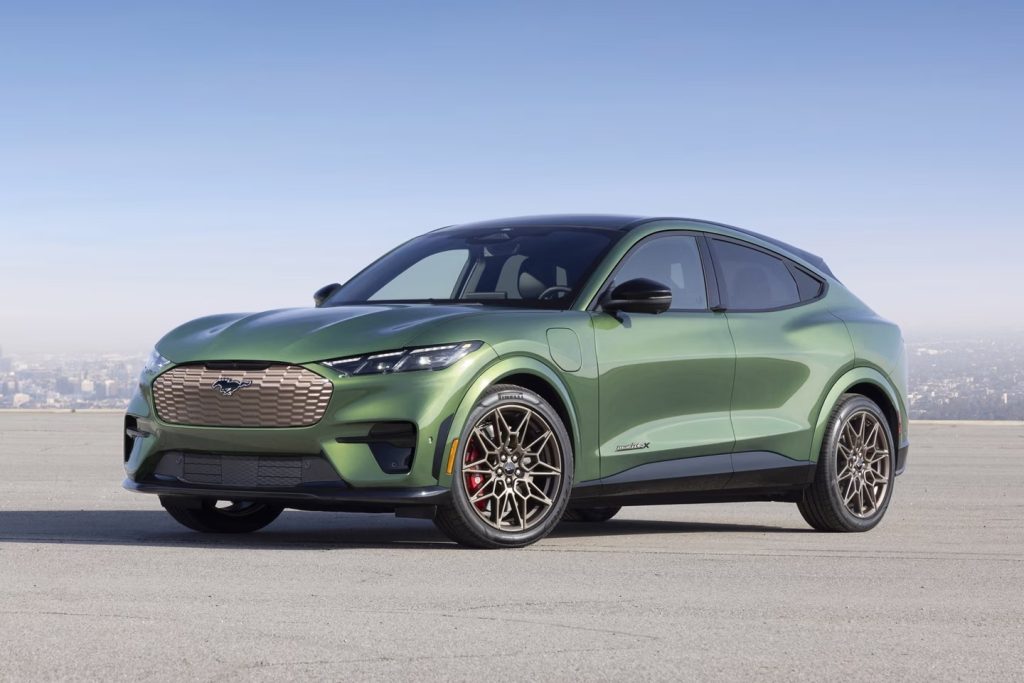
Available in various configurations, the Mach-E offers options ranging from the high-performance Sport Edition to a more efficient rear-wheel-drive version with a long-range battery.
Powered by two electric motors delivering 346 horsepower and 428 lb-ft of torque, it provides an estimated range of 224 miles per charge. The Ford Mustang Mach-E is a symbol of the new era of muscle cars, and it’s only set to improve with time.’
2025 Rivian R1S
Next, the 2025 Rivian R1S, with a 16-inch touchscreen, pushes the envelope further into the electric vehicle future. Its rugged exterior design still exudes off-road prowess, while its sleek, modern interior boasts premium materials.
With two electric motors generating 553 horsepower and 610 lb-ft of torque, the R1S has a 270-mile range per charge, offering both exhilarating acceleration and a comfortable, stable ride off-road.
The cabin is equipped with ample luxury features, and for those seeking even more power, there are configurations with tri- and quad-motor setups that reach a staggering 1,025 horsepower.
The Rivian R1S is designed to be as dynamic as it is durable, making it a formidable choice for adventure enthusiasts and tech lovers alike.
The 2025 Rivian R1S, much like the R1T electric pickup it shares its platform with, strikes an impressive balance between luxury, performance, and off-road capability—something rarely seen in a single vehicle.
While the R1T features a two-row layout, the R1S expands on that with a three-row configuration that accommodates up to seven passengers.
Initially introduced for the 2022 model year, the R1S enters its second generation in 2025, boasting substantial improvements in both powertrain options and onboard technology. In this evolving EV SUV market, the R1S goes head-to-head with the BMW iX, Volvo EX90, Tesla Model X, and Kia EV9.
For 2025, Rivian introduces a host of updates to the R1S. These include a new electrical architecture and compute platform, a tri-motor powertrain, and increased output for the quad-motor version.
Battery packs have been revised for better efficiency, with the Max pack offering more range than before. The heat pump system has been redesigned, and the new Rivian Autonomy Platform supports advanced driver-assist features.
Updates extend to the exterior lighting as well, with new taillights and headlights featuring optional beam-adapting technology. The suspension system has been reworked, and Rivian now offers three wheel and tire packages, including a set of 22-inch wheels optimized for aerodynamics.
The infotainment system gets a complete redesign with improved usability, and digital key compatibility has been added for Apple Wallet and Google Pixel users. The new Connect+ system enables Google Cast and YouTube streaming, and two premium Ascend interior packages are now available.
Additional refinements include an optional Storm Blue exterior, blackout trim accents, an electronically dimmable glass roof, customizable interior lighting themes, and a more effective wireless phone charger. Many features, including performance and driver assist capabilities, can now be added or expanded via over-the-air (OTA) software updates.
A notable OTA update scheduled for March 2025 adds even more capability. Dual-motor models from both the first and second generations equipped with Standard+, Large, or Max battery packs can receive a Performance Upgrade that unlocks 665 horsepower and 829 lb-ft of torque.
This also enables three new drive modes: Sport, Rally, and Soft Sand. All Performance dual-motor models will get Rally mode as standard, offering sharper throttle and steering response.
A new Wheel Swap feature allows drivers to change the wheel type in the system settings to get the most accurate range estimate. Enhanced Highway Assist is rolled out for second-generation vehicles, enabling hands-free driving.
Other additions include Tire Puncture Detection for Gen 1 and 2 models, a Go Chime that alerts drivers when stopped traffic begins moving again, auto-tilting side mirrors when reversing, and mobile app control for the charge port door.
The Rivian R1S stands out as a uniquely capable and luxurious electric SUV. It offers genuine three-row utility without compromising comfort or quality.
Rivian has made a point of ensuring the third-row seating isn’t an afterthought, with the same premium materials and amenities—soft vegan leather, USB ports, cupholders, and dedicated air vents—as the front rows.
Access to the third row is straightforward, which isn’t something most large SUVs can claim. Admittedly, cargo space with all three rows upright is limited, but the large front trunk (frunk) helps offset this drawback.
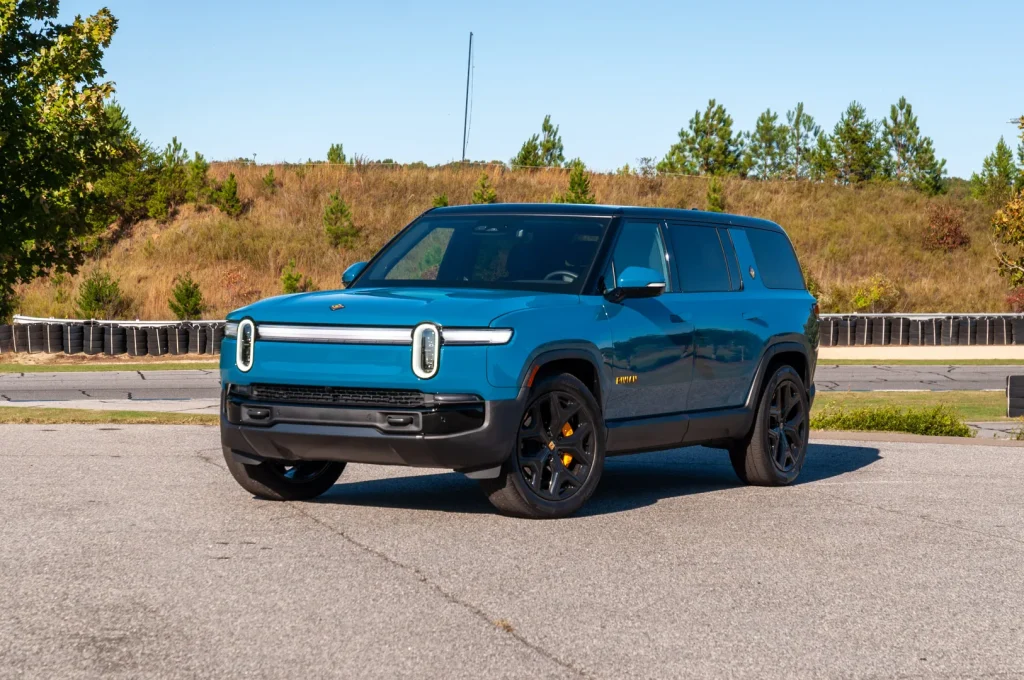
Driving the R1S is just as rewarding as riding in it. The electric powertrains deliver instant, thrilling acceleration, and the handling is sharp and composed.
One-pedal driving is among the best available in any EV today. Thanks to its height-adjustable air suspension and off-road drive modes, the R1S is just as comfortable on rugged terrain as it is cruising on the highway.
During initial testing of the 2025 model, the updated suspension showed impressive capability—absorbing bumps with poise and providing a smooth, stable ride with minimal head toss. Rear passengers also experienced notable improvements in comfort.
One of the most welcome updates is the extended driving range, especially for the Max battery pack. Rivian has also addressed a common complaint about the previous model’s glass roof, replacing it with a dimmable unit that reduces heat intrusion. That said, not everything has been perfected.
The brake pedal still has excessive travel, and basic functions like adjusting air vents are still only accessible through the infotainment screen—physical controls would improve usability. Even so, these are relatively minor complaints when weighed against the R1S’s overall excellence. The 2025 model is still one of the best all-around electric SUVs available.
Built on a new electrical platform, the second-generation R1S now supports the tri-motor powertrain and achieves better range thanks to reengineered battery packs.
The Max pack delivers up to 420 miles of estimated range, while the Large pack offers about 330 miles. A new Standard pack with lithium iron phosphate chemistry provides a respectable 270 miles.
All R1S variants can regain roughly 140 miles of range in about 20 minutes when connected to a Level 3 DC fast charger. Rivian’s compatibility with Tesla’s Supercharger network further increases charging convenience.
In terms of performance, the tri-motor layout adds a new dimension. Featuring two rear motors and one up front, this configuration produces 850 horsepower and 1,103 lb-ft of torque, propelling the R1S from 0 to 60 mph in an estimated 2.9 seconds. All 2025 R1S models come with all-wheel drive.
The standard dual-motor system, carried over from the previous generation, delivers 533 horsepower and 610 lb-ft of torque, with a 0-60 time of about 4.5 seconds. Rivian also offers a Performance Dual-Motor setup that increases output to 665 horsepower and 829 lb-ft of torque, trimming the 0-60 time to 3.5 seconds.
At the top of the range, the quad-motor model receives a substantial power boost, now generating 1,025 horsepower and up to 1,198 lb-ft of torque when Launch Mode is engaged. This allows the R1S to rocket from 0 to 60 mph in just 2.5 seconds—over half a second faster than the previous version.
The 2025 Rivian R1S refines and builds on the strengths of its predecessor, combining enhanced performance, more range, smarter tech, and premium comfort into a truly well-rounded package. It’s not just an electric SUV—it’s one of the most compelling vehicles on the road today.
Also Read: Top 10 Worst and 10 Best Trucks for Towing
2024 GMC Sierra EV
The 2024 GMC Sierra EV, with its 16.8-inch touchscreen, is another standout in the electric vehicle market. Sharing its powertrain with the Chevrolet Silverado EV and the Hummer EV, the Sierra EV Denali introduces some key features that set it apart, such as the standard Multipro Midgate, which extends the bed to an impressive 10 feet 10 inches for additional cargo space.
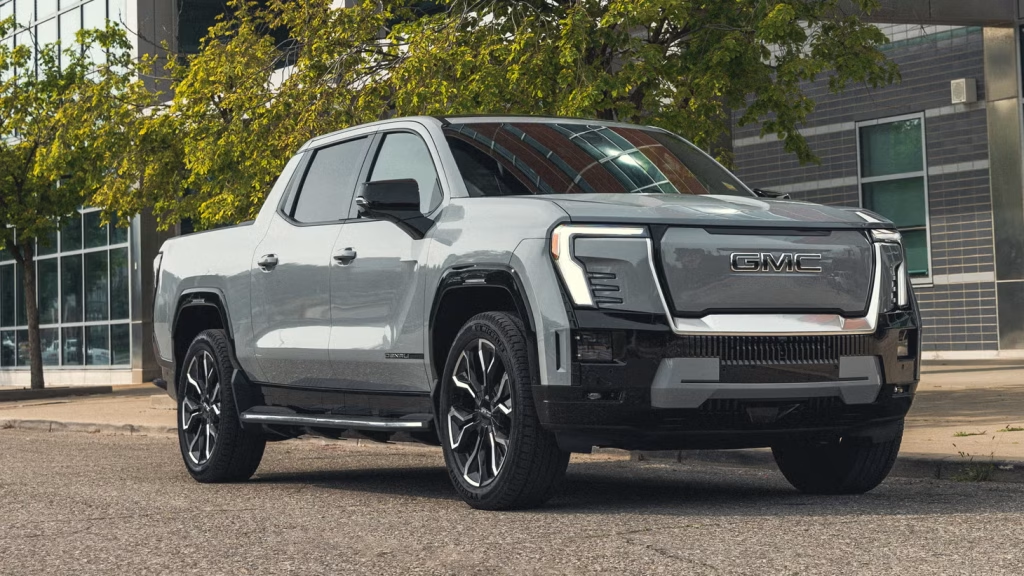
The Sierra EV is equipped with two electric motors delivering 754 horsepower and 785 lb-ft of torque, offering a range of around 440 miles per charge. It’s designed as both a hard-working pickup and a tech hub, with a premium sound system and a dynamic infotainment display.
Additionally, the truck’s off-board power system provides up to 10.2 kW, making it a great option for outdoor activities or on-the-go power needs. With its combination of utility, power, and advanced technology, the Sierra EV is poised to take on any challenge.
Porsche Taycan
The Porsche Taycan features a 16.8-inch touchscreen, offering a simple layout with a fixed menu bar on the left and a tab bar across the top. This design is easy to learn and highly adaptable, allowing even those unfamiliar with advanced technology to navigate it with ease.
The screens, although slightly short and stretched across the dashboard, take some getting used to, but ultimately, they prove to be quite user-friendly for the driver. The size of the screen makes it easier to view essential controls, contributing to a more comfortable driving experience.
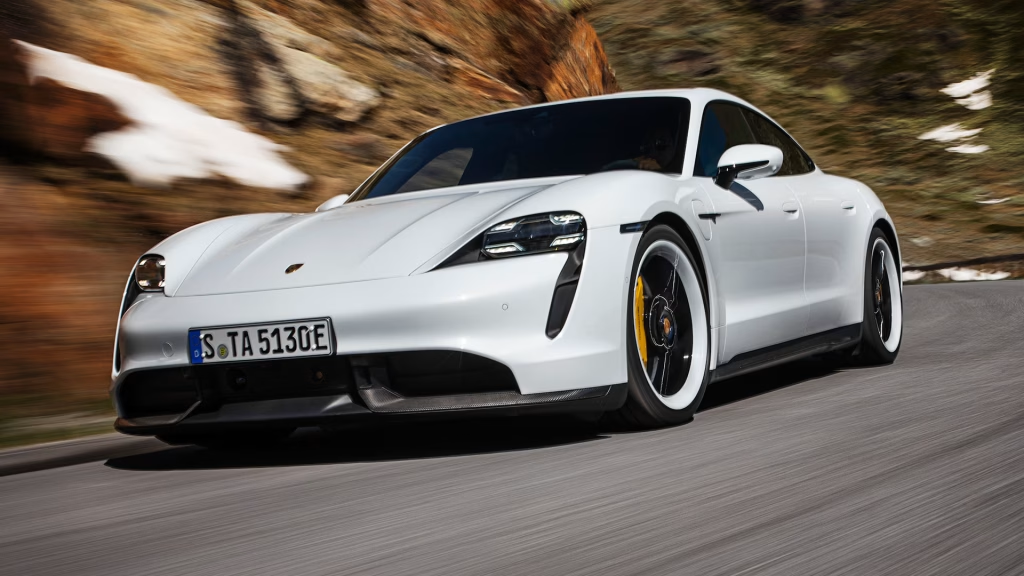
The Taycan is a high-performance, all-electric car, known for its appeal among sports car enthusiasts who enjoy winding roads. It comes in three distinct body shapes, each offering different motor and battery configurations.
The Taycan offers models like the Turbo and Turbo S with all-wheel drive, ensuring you have the necessary traction to keep the car firmly on the road. Under the hood, the Taycan is powered by two electric motors, delivering 590 horsepower and 626 pound-feet of torque, with an estimated range of 238 miles per charge.
Tesla Model X
The Tesla Model X, which is equipped with a 17-inch touchscreen, takes things even further with multiple touchscreens throughout the cabin, including both front and rear. These screens control numerous features, from cabin heating and air conditioning to headlights and entertainment.
The touchscreen system is highly customizable, allowing drivers to tailor the Model X to their preferences. It also includes hands-free voice commands, making driving this electric SUV feel almost futuristic, like something out of a superhero movie.
The Model X comes with two electric motors that produce 532 horsepower and 713 pound-feet of torque, and it offers an impressive range of 348 miles per charge.
Tesla has long been a leader in the electric vehicle industry, and while the Model X’s performance is strong, the Model X Plaid version takes it to a whole new level with a staggering 1,020 horsepower, ensuring a thrilling driving experience for those seeking a higher level of power and acceleration.
Technically speaking, the Tesla Model X falls under the SUV category. However, due to its battery pack being mounted low within the chassis, the Model X enjoys a significantly lower center of gravity than traditional gas-powered SUVs.
This contributes to sharper handling and a more composed driving experience overall. Still, the ride quality can be on the stiffer side, especially if you opt for the available 22-inch wheels. Fortunately, all-wheel drive is standard across all trims, which enhances the vehicle’s stability and all-weather capability.
For the 2025 model year, the Model X offers two powertrain options. The base configuration uses dual electric motors that together produce 670 horsepower, enabling a 0-60 mph sprint in just 3.8 seconds.
Those looking for even more performance can go for the Plaid trim, which features a tri-motor setup that generates an astonishing 1,020 horsepower.
With this powertrain, the Model X Plaid rockets from zero to 60 mph in just 2.5 seconds. Regardless of which version you select, acceleration is nothing short of exhilarating—the Model X leaps off the line and quickly reaches “what-seems-to-be-the-problem-officer” speeds with a level of urgency that’s almost unnerving.
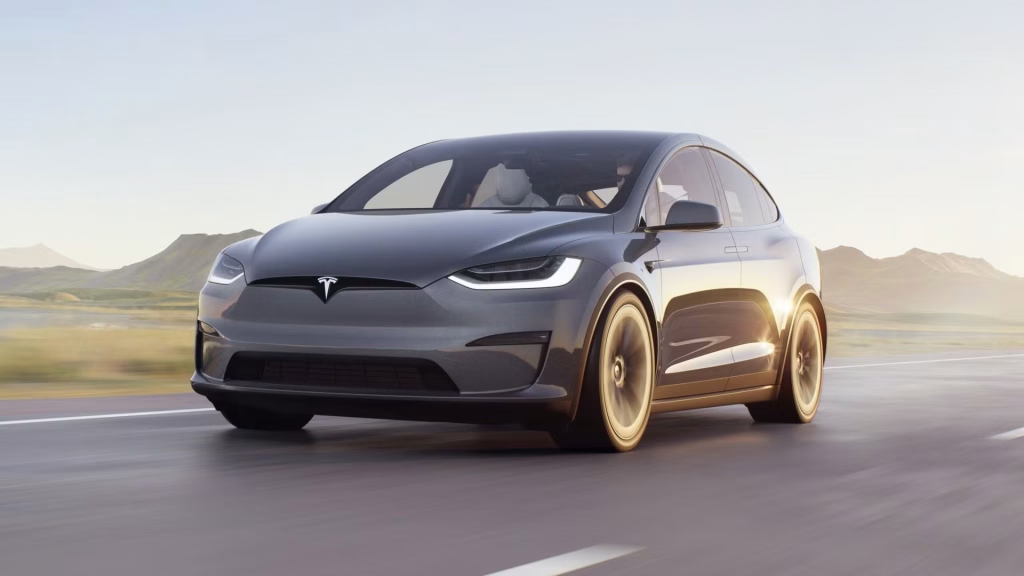
The Model X also performs well in terms of efficiency. The 2025 Model X Plaid with 20-inch wheels delivers a driving range of up to 314 miles on a full charge and earns EPA ratings of 98 MPGe in the city and 89 MPGe on the highway.
Models equipped with larger 22-inch wheels see a slight reduction, with a maximum range of 294 miles and ratings of 92 MPGe city and 84 MPGe highway.
While the EPA has not yet officially tested the 2025 dual-motor variant, the mechanically similar 2024 model achieved 104 MPGe city and 96 MPGe highway, along with an impressive maximum range of 335 miles.
Charging capabilities vary depending on the setup. Using a 240-volt Level 2 public or home charger, the Model X can regain up to 30 miles of range per hour.
However, Tesla’s expansive Supercharger network offers a much quicker solution, enabling the vehicle to recoup up to 171 miles of range in as little as 15 minutes. This makes long-distance travel significantly more practical for Tesla owners.
For those considering leasing a Model X, the U.S. News Best Price Program could provide added savings. On average, customers save about $3,009 off MSRP, which can translate into monthly lease savings of approximately $83 over a standard 36-month lease term.
Inside, the 2025 Model X emphasizes minimalism, which may not appeal to everyone. The interior design is clean and modern, but it lacks some of the luxurious touches and material quality found in rival electric SUVs. The build quality is inconsistent, which stands out more in the luxury segment.
In terms of seating, the base Model X is available in five-, six-, or seven-seat configurations, whereas the Plaid version is offered solely as a six-seater with three rows. When it comes to storage, the Model X excels.
Between its rear cargo area and the front trunk (or frunk), it offers a total of 92 cubic feet of cargo space—plenty of room for gear, groceries, or luggage. Despite its strong performance and high-tech appeal, the 2025 Model X has a below-average value rating for a luxury electric SUV.
This score reflects both its pricing across trim levels and its projected total cost of ownership, including depreciation, insurance, maintenance, and energy costs over time. While it’s undeniably quick and advanced, those looking for the best long-term value in the segment may want to consider other options.
Tesla Model S
Similarly, the Tesla Model S, with its 17-inch touchscreen, continues the trend set by the Model X, but as a luxury sedan, it offers its own unique driving experience. The large screen dominates the interior, controlling nearly every function within the vehicle.
While the touch-based controls can be difficult to get used to, many owners have noted that the reliance on the touchscreen can be overwhelming. Despite this, the Model S excels in performance, especially the Model S Plaid, which is capable of launching from 0 to 60 MPH in just 2.4 seconds.
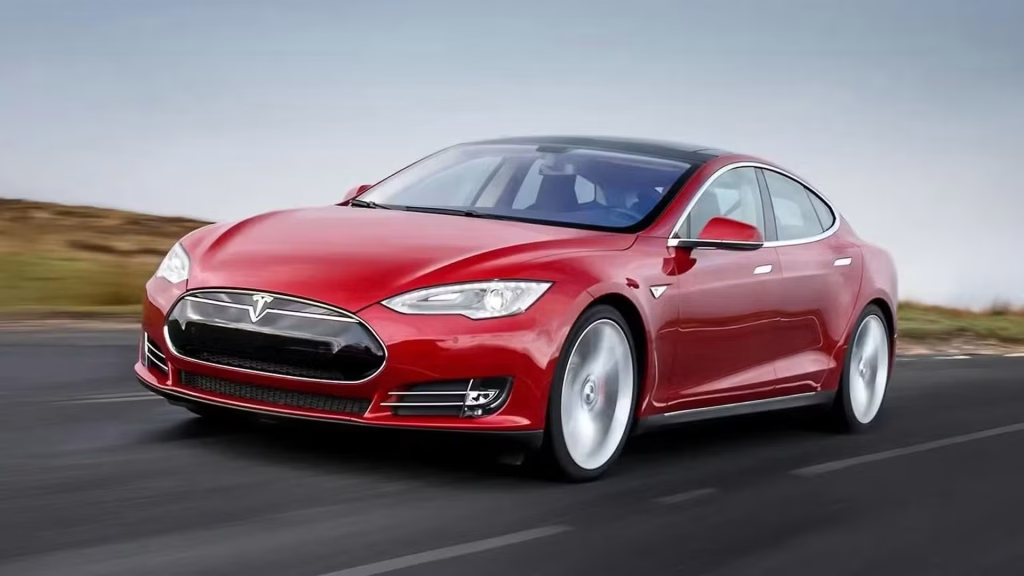
Powered by three electric motors, it generates an astonishing 1,020 horsepower and 1,050 pound-feet of torque, with a range of 348 miles per charge.
While the era of enormous touchscreens may eventually slow down, the Model S continues to provide an exceptional driving experience with its combination of luxury, sportiness, and raw power.
2024 Chevrolet Silverado EV
The 2024 Chevrolet Silverado EV shares its electric powertrain with the rugged GMC Hummer EV, combining a tough utility feel with the futuristic nature of an electric vehicle.
This fusion results in a sleek appearance reminiscent of the early 2000s Chevrolet Avalanche, which successfully maintains the classic, road-dominating presence of a Chevy pickup, even in its electric form.
The Silverado EV’s versatility is enhanced by its impressive charging options, with the ability to gain 100 miles of range from just a 10-minute charge. Additionally, it maintains a strong towing capacity of up to 10,000 pounds, making it a capable workhorse.
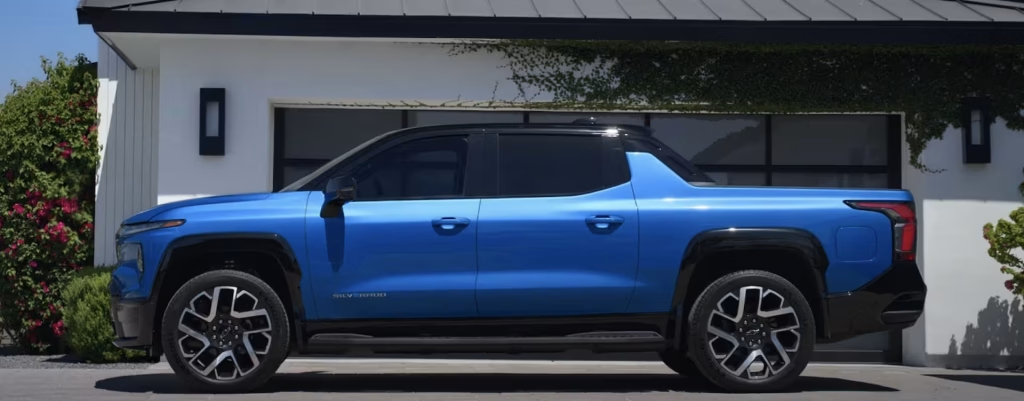
Inside the cabin, the Silverado EV is just as comfortable and accommodating as any gas-powered Silverado, if not more so, thanks to its advanced technology and comfort features, including a 17.7-inch infotainment screen, an 11.3-inch digital cluster, and multiple electric outlets.
Powered by two electric motors, it delivers 754 horsepower and 785 pound-feet of torque, with an estimated range of 440 miles per charge.
Audi A8
The Audi A8, with its 18.7-inch combined touchscreen display, is a luxurious sedan that takes technology to a new level. The integrated display includes an upper 10.1-inch screen and a lower 8.6-inch screen, alongside the 12.3-inch Virtual Cockpit cluster that has become a signature of Audi’s design.
This impressive array of screens is paired with innovative technology, making the A8 a standout in its class. Beneath the sleek exterior, the A8 is powered by a 3.0-liter turbocharged V6 hybrid engine that generates 335 horsepower and 369 pound-feet of torque, offering a refined driving experience with an 8-speed automatic transmission and all-wheel drive.
The vehicle’s fuel economy stands at 19/28/22 mpg (city/highway/combined), making it efficient for its size. Audi has also gone the extra mile to ensure a quiet ride by incorporating sound-deadening materials into the cabin, allowing the occupants to enjoy a smooth journey free from external noise.
Whether you’re listening to stories from a family road trip or relaxing in the luxurious interior, the A8’s cabin offers a peaceful retreat.
The Audi A8 embodies all the hallmark qualities of a full-size luxury sedan. It offers a spacious and quiet interior, elegant and understated styling, a capable—though not segment-leading—powertrain, and a surprisingly agile chassis.
However, its biggest weakness lies in its subdued presence, which prevents it from generating the same excitement as the more visually assertive BMW 7-series and Mercedes-Benz S-class—its chief rivals.
Powering the A8 is a 335-horsepower turbocharged V-6 engine, which, while smooth and silent, falls short of the more powerful turbocharged inline-sixes found in both the BMW and Benz.
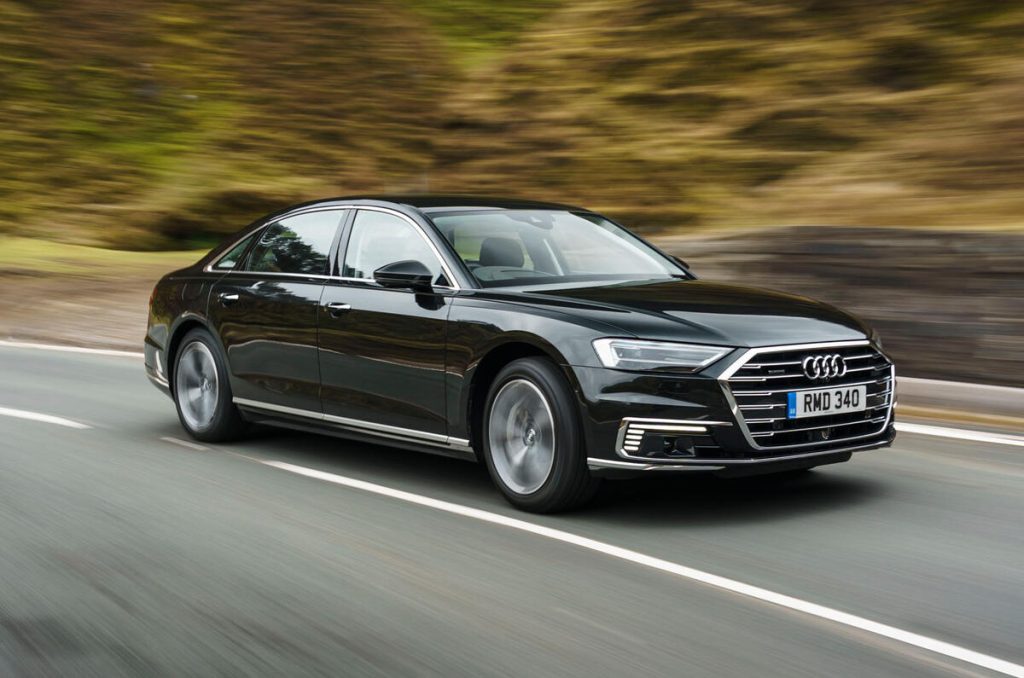
All three vehicles feature a 48-volt hybrid assist system. On the plus side, the A8’s base price is noticeably lower than that of its competitors, making it a smart pick for discerning buyers seeking luxury without overpaying.
Despite not being the most muscular in its class, the A8’s engine still delivers a spirited experience when paired with its all-wheel-drive chassis—especially on long, flowing roads. With dynamic all-wheel steering available, the car’s handling improves further.
That said, buyers wanting a V-8 engine and sharper performance should consider the high-performance Audi S8, which is reviewed separately.
For the 2025 model year, the A8 receives a series of cosmetic and feature upgrades. The Black Optic package now includes new 21-inch double-spoke wheels with a bi-color finish, which pair well with black brake calipers and blacked-out trim.
Dynamic all-wheel steering becomes standard with the luxury package, and leather trim now extends to the top of the dashboard and doors, adding to the sense of refinement.
The Executive package has also been enhanced to include Valcona leather, heated rear seats, a head-up display, and HD Matrix-design LED headlights.
Meanwhile, the long-wheelbase A8 L gains a heated steering wheel and 20-inch bi-color alloy wheels as standard. Across all trims, the Homelink garage buttons have been relocated to the rearview mirror, and a new Madeira Brown exterior paint option has been added to the color palette.
The 2025 Audi A8 starts at $93,295, and it’s a car that encourages buyers to invest a little extra to enjoy the full luxury experience. The Black Optic package is highly recommended, as it adds gloss-black exterior accents, black Audi rings and badges, black brake calipers, and the newly designed 21-inch 10-spoke wheels with a bi-color finish.
Other desirable additions include massaging front seats, heated armrests, and HD Matrix-design LED headlights. For those who prioritize rear-seat comfort, the Comfort Rear Seat package is an excellent choice.
It adds ventilated and massaging power-adjustable outboard seats, heated rear armrests, and a remote control for the rear entertainment system. Lastly, the Executive package rounds out the offering with adaptive cruise control with lane keeping, a head-up display, and remote parking functionality.
The A8 is powered by a turbocharged 3.0-liter V-6 engine that delivers 335 horsepower and benefits from a 48-volt hybrid system. (For those craving more power, the S8 offers a 563-horsepower turbocharged V-8.) All models come equipped with an eight-speed automatic transmission and Audi’s Quattro all-wheel drive.
Also Read: Top 10 Worst and 10 Best Trucks for Towing
BMW i7
The BMW i7 stands out with its 31.3-inch “Theater Screen” at the rear, a massive touchscreen that offers full control over the car’s features, including climate control, sound system, and a range of electric options, from seat warmers to headlights.
While it’s not the primary dash touchscreen, this rear screen adds an extra layer of luxury and functionality, making the i7 feel like a rolling theater. The i7 is powered by two electric motors, generating 536 horsepower and 549 pound-feet of torque, with an estimated range of 296 miles per charge.
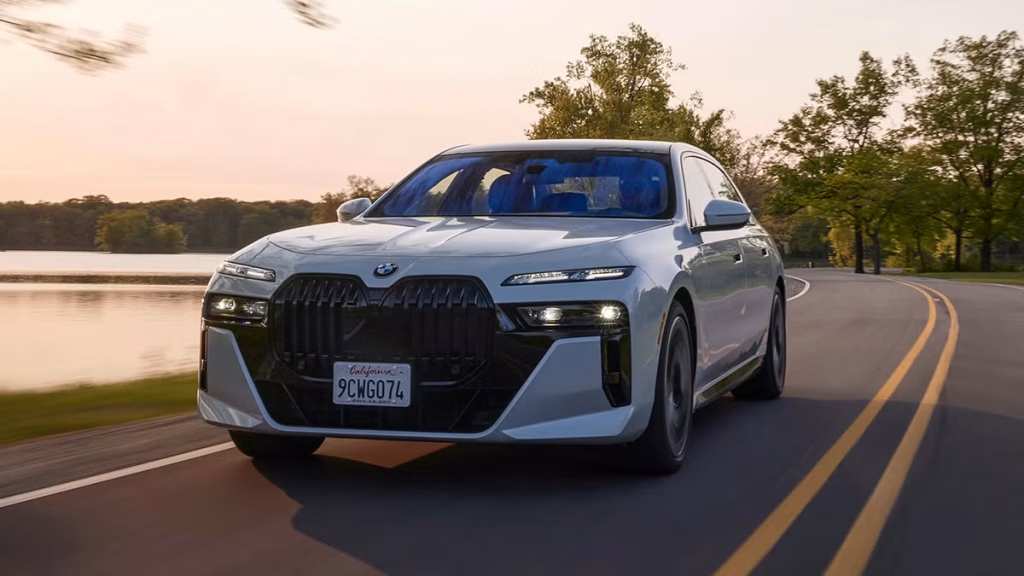
While the i7 is a large luxury sedan and may not deliver sports car-like handling, it offers an exceptional driving experience with superior handling for its size. Inside, the technology and luxury are second to none, justifying the i7’s price tag of over $100,000.
The combination of advanced technology and high-end luxury makes the i7 a standout in its class, and its price reflects not just the BMW name but the remarkable features and driving experience it provides.
2024 Cadillac XT4
The 2024 Cadillac XT4 features a remarkable 33-inch diagonal display, a suite of over 12 standard safety and driver-assistance features, and an impressive 39.5 inches of rear legroom, making it stand out in its category. Cadillac has long maintained a prestigious position among American automobile brands, known for its combination of quality and luxury.
This legacy continues as the brand integrates advanced, premium components and features into its vehicles, elevating them as some of the finest on the market. The XT4 represents this tradition, offering a blend of modern luxury with classic Cadillac appeal.
The exterior design of the XT4 echoes the familiar dimensions of a typical small SUV but distinguishes itself through distinctive Cadillac elements, including elegant contours, a prominent grille, and the brand’s iconic headlamps.
Inside, the XT4 showcases opulence, featuring premium leather and a sophisticated layout that highlights the vehicle’s modern technology while maintaining a luxurious feel.
Key features include the aforementioned large touchscreen, an available heads-up display, and built-in Google integration, along with other high-end amenities.
Powered by a 2.0-liter turbocharged 4-cylinder engine, the XT4 delivers 258 horsepower and 235 pound-feet of torque, paired with a 9-speed automatic transmission and an all-wheel-drive system. It achieves a combined fuel economy of 26 MPG, making it a practical yet luxurious choice.
The 2024 Cadillac XT4 continues its run in the subcompact luxury SUV segment with a modest refresh rather than a full redesign. This marks the sixth year of the current XT4 generation, which originally debuted in 2019.
While subcompact luxury SUVs generally offer a premium feel and high-end features in a smaller, more affordable package, the XT4 has struggled to stand out in a competitive field. That said, it still brings notable strengths to the table, including a spacious interior and cargo area, as well as an impressive array of standard technology features.

For 2024, the most significant upgrade comes inside the cabin, where a fully digital instrument cluster and new infotainment system bring the dashboard into the modern era. However, much of the vehicle’s overall execution remains dated, with flaws in ride quality, cabin noise, and control usability continuing to hold it back.
One of the standout changes for 2024 is the revamped dashboard. Previously, the XT4 featured a conventional setup with a separate 8-inch center touchscreen and a hooded instrument cluster.
The updated design replaces this with a sleek 33-inch display that merges the digital gauge cluster and infotainment screen into one continuous panel. This modern interface now incorporates “Google built-in” technology, which expands functionality far beyond typical smartphone integration.
With Google built-in, drivers can access Google apps directly from the vehicle without needing to connect a phone. Features include controlling smart-home devices, downloading apps through Google Play, and managing in-car functions such as climate settings and audio volume using voice commands.
Despite the tech improvements, the XT4 still lags behind many of its rivals in key areas. Its ride quality is on the busy side for a luxury SUV, and the cabin suffers from noticeable engine and road noise. Some interior controls are also confusing to operate, which detracts from the overall premium feel.
In comparison, many competitors in the compact luxury SUV segment offer a smoother ride, more refined powertrains, and more luxurious interiors. Top picks in this class include the BMW X1, Mercedes-Benz GLA and GLB, and the Volvo XC40—all of which offer a more well-rounded driving and ownership experience.
While it doesn’t offer a dramatic increase in standard features over the base trim, it does unlock access to important option packages that aren’t available on the Sport model.
Chief among these is the Active Safety package, which significantly enhances the XT4’s suite of driver assistance features.
The Comfort and Convenience package is another key upgrade, adding heated and ventilated front seats with lumbar massage, as well as heated outboard seats in the second row—making the XT4 feel more in line with its luxury label.
In terms of cost, estimated fuel expenses for the 2024 Cadillac XT4 Luxury trim are about $186 per month, assuming 15,000 miles of driving per year split between 55% city and 45% highway usage, and with premium unleaded fuel priced at $3.90 per gallon in North Dakota.
For context, this is slightly higher than the $176 monthly average for midsize SUVs in the same region. Overall, while the 2024 XT4 benefits from a welcome tech overhaul, it remains a step behind its rivals in several fundamental areas.
Lucid Air
The Lucid Air, with its 34.0-inch display, sets itself apart from many other modern vehicles by focusing on functionality rather than excessive futuristic designs.
Its display is divided into three panels: the left panel controls critical functions like headlights, locks, and windshield wipers, the central panel displays vital information such as speed and charge level, and the right panel serves as the main infotainment screen, managing media, navigation, and communication.
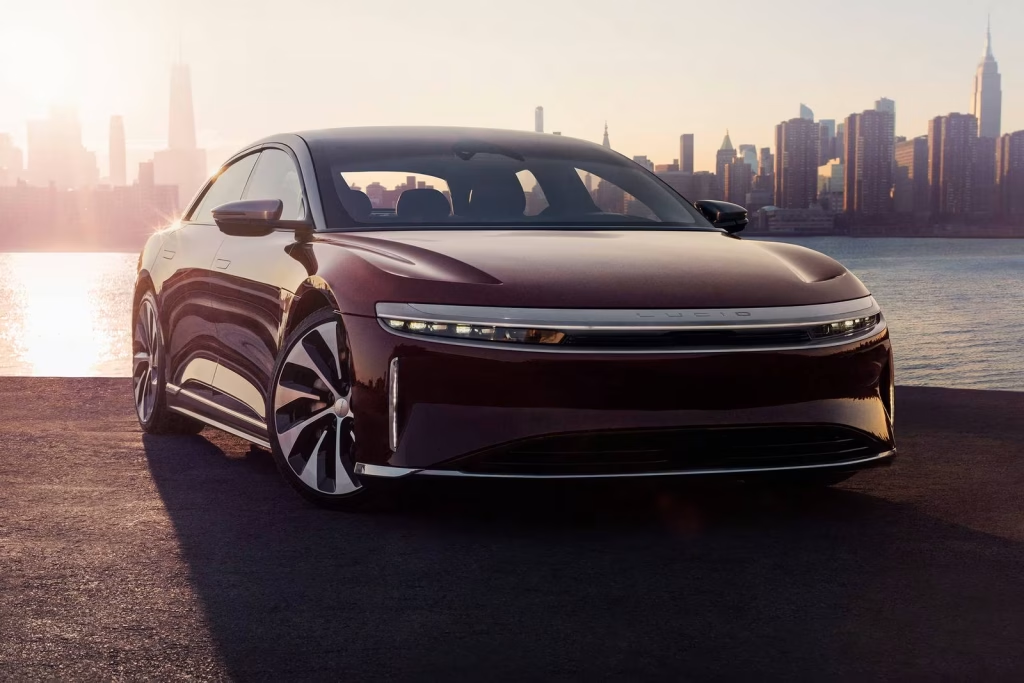
The Lucid Air is undoubtedly one of the most impressive electric vehicles, offering a blend of performance and efficiency. With two electric motors, it produces 620 horsepower and 885 pound-feet of torque, driving all four wheels.
Its range extends up to 384 miles per charge, and it can accelerate from 0 to 60 mph in under 2 seconds. The Lucid Air also boasts a top speed of 170 mph, though this is electronically limited by the manufacturer. The combination of high performance and long-range capabilities makes the Lucid Air a true standout in the EV market.
Cadillac Escalade
The Cadillac Escalade is a flagship SUV that combines size with luxury, featuring a 38.0-inch touchscreen. Since its introduction in 1999, the Escalade has been Cadillac’s signature SUV, offering a large vehicle experience without sacrificing luxury.
Unlike many competitors that add a touchpad on the center console, Cadillac has integrated the touchscreen directly into the dashboard, offering a sleek and modern look. Powered by a 6.2-liter supercharged V-8 engine, the Escalade generates 682 horsepower and 653 pound-feet of torque, paired with a 10-speed automatic transmission and all-wheel drive.
It provides a fuel economy of 14/18/16 MPG (city/highway/combined). Inside, the Escalade is equipped with premium materials like wood, leather, satin, and designer fabrics, emphasizing luxury.
Cadillac has also focused on integrating cutting-edge technology, particularly in driver assistance systems, to enhance the driving experience and ensure that every journey in the Escalade is as smooth and enjoyable as possible. This blend of size, luxury, and technology makes the Escalade an iconic choice for those seeking both power and sophistication in their vehicle.
The Cadillac Escalade continues to assert its dominance in the full-size luxury SUV space, offering a commanding presence and an extensive list of tech-forward features.
As Cadillac’s premier three-row SUV, the Escalade for 2025 introduces a series of styling refinements aimed at aligning its appearance with the brand’s evolving electric vehicle design language, as seen in models like the Escalade IQ and the Lyriq.
Despite these modern touches, the Escalade retains its traditional body-on-frame construction, which it shares with its corporate cousins, the Chevrolet Tahoe and Suburban. Its primary focus remains on delivering high-end comfort and capability for up to eight passengers.
In a market populated by rivals like the Lincoln Navigator, Jeep Grand Wagoneer, and Lexus LX600—all of which offer similar blends of size, luxury, and price—the Escalade still stands out. It’s a heavy vehicle, yet it offers composed handling and a cushioned ride that fits its premium mission.
The distinctive curved OLED display returns for 2025, now stretching across the entire dashboard, adding to the vehicle’s tech-forward appeal. For those needing additional storage behind the third row, the extended-wheelbase ESV variant is available.
A 420-hp 6.2-liter V-8 comes standard, while performance enthusiasts can choose the Escalade-V, which delivers exhilarating acceleration thanks to a 682-hp supercharged V-8. With this well-rounded combination of luxury, space, and power, the 2025 Escalade continues to earn high praise and has secured a spot on the Editors’ Choice list.
It trails only the BMW X7 and the Land Rover Range Rover, with a starting price of $90,295. It slightly undercuts the Mercedes-Benz GLS-Class in price, while also competing with high-end options like the Mercedes-AMG GLS-Class and BMW XM.
For the 2025 model year, Cadillac has made several updates to the Escalade’s exterior. These include a reworked front fascia that features a larger grille with new pattern designs, slimmer daytime running lights situated just beneath the hood crease, and sleek horizontal LED headlamps.
An illuminated grille surround is now available for added flair. Around back, changes include redesigned taillights, a new lower bumper cover, and a few subtle trim enhancements. The 2025 Escalade also introduces available 24-inch wheels—the largest ever offered on this model. New exterior color choices include Deep Sea metallic, Latte metallic, and Aegean Stone.
Inside, the previously 38-inch curved OLED display now spans an impressive 55 inches, stretching from pillar to pillar. The steering wheel has been redesigned, and two new interior color schemes—Renaissance Red and Sheer Gray—have been added.
The Escalade-V receives additional carbon-fiber accents and exclusive quilted upholstery. Super Cruise, GM’s hands-free driving system, is now standard across the entire lineup. However, the previously available diesel 3.0-liter inline-six engine has been discontinued.
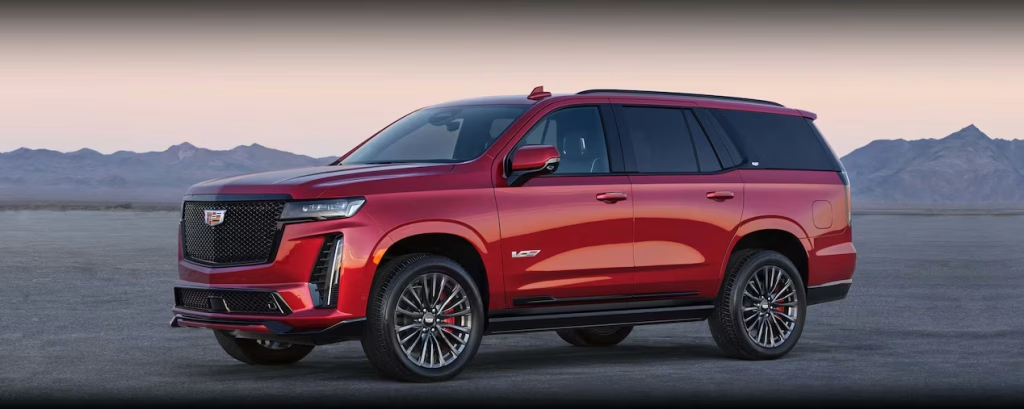
Pricing for the 2025 Cadillac Escalade and Escalade ESV varies widely based on trim level and options. The base RWD Luxury model starts at $90,295, while the top-tier AWD V-Series can reach up to $167,695. Given the Escalade’s premium positioning, Cadillac buyers are less likely to skimp on features.
The best value lies in the Premium Luxury Platinum trim, which offers an expansive list of amenities including an adaptive suspension with air springs, a 36-speaker AKG premium audio system, semi-aniline leather upholstery, 16-way power front seats with massage, and a power door feature that opens and closes all four doors with either the door handle or a console-mounted button.
For those seeking peak performance, the Escalade-V is the obvious choice. Production of the 2025 Escalade will begin in late 2024 at GM’s Arlington Assembly facility in Texas.
Under the hood, the standard Escalade is equipped with a 420-hp 6.2-liter V-8 engine paired with a 10-speed automatic transmission. It’s available with either rear- or all-wheel drive.
The previously available diesel option, which offered improved fuel economy but less power, has been removed from the lineup. For buyers looking for unmatched acceleration and power in a luxury SUV, the Escalade-V delivers with a supercharged 6.2-liter V-8 producing 682 horsepower.
The engine’s deep exhaust note and massive thrust leave a strong impression. As with the related Chevrolet Tahoe, Suburban, and GMC Yukon, the Escalade benefits from an independent rear suspension setup that provides increased third-row legroom compared to the prior generation, which used a solid rear axle.
Premium trims enhance ride comfort further with air springs and adaptive dampers. While the Escalade handles better than many traditional SUVs, the V model still doesn’t quite match the agility of performance-focused competitors like the Mercedes-AMG GLS63 or BMW Alpina XB7.
In terms of performance benchmarks, Cadillac hasn’t recently tested the latest Escalade with a stopwatch, but the long-wheelbase 2021 Escalade ESV with a V-8 reached 60 mph in a respectable 5.9 seconds. The Escalade-V, however, delivered truly impressive results—reaching 60 mph in just 4.3 seconds and completing the quarter mile in 12.7 seconds at 111 mph.
Fuel economy remains a weak point for the Escalade, particularly with the larger engines. The standard V-8 models with rear-wheel drive are rated at 14 mpg city, 19 mpg highway, and 16 mpg combined. Opting for all-wheel drive reduces highway mileage by one mpg.
The Escalade-V, focused on performance, is even less efficient, earning EPA ratings of just 11 mpg in the city and 16 mpg on the highway.
2023 Lincoln Nautilus
The 2023 Lincoln Nautilus is a luxury SUV that combines a hybrid drivetrain with a platform shared with the rugged Ford Bronco Sport and Ford Maverick. Now equipped with all-wheel drive as standard, it delivers both luxury and practicality, offering features like ambient lighting and leather-wrapped seats, perfect for daily use.
The infotainment system is one of the most striking aspects of the Nautilus, featuring two separate screens, each just under 24 inches, which combine for a total screen size of 48 inches.
In terms of performance, the standard engine is a turbocharged 2.0-liter four-cylinder, but the more powerful upgrade is a 2.7-liter twin-turbocharged inline six-cylinder, which produces 335 horsepower and 380 pound-feet of torque.

This engine allows the Nautilus to accelerate from 0 to 60 mph in 5.8 seconds. While not an outright sports car, this level of performance ensures it’s more than capable of keeping up with highway traffic.
The Nautilus also comes with standard features like CoPilot 360, which enhances safety with advanced driver-assist technologies, and Ford’s latest Sync-4 system, enabling seamless connection with both Apple and Android devices. Fuel efficiency is decent, with a combined 21 mpg, including 19 mpg in the city and 25 mpg on the highway.
2024 Cadillac Celestiq
The 2024 Cadillac Celestiq takes luxury to new heights with its massive 55-inch touchscreen that dominates the dashboard. This futuristic display provides complete control over the vehicle’s climate, multimedia, and more, solidifying the Celestiq’s status as a contender for the title of “King of Luxury Cars.”
The Celestiq is an all-electric luxury flagship, and while specific range details may change as more real-world testing occurs, it promises to combine advanced technology with the luxurious comfort that Cadillac is known for.
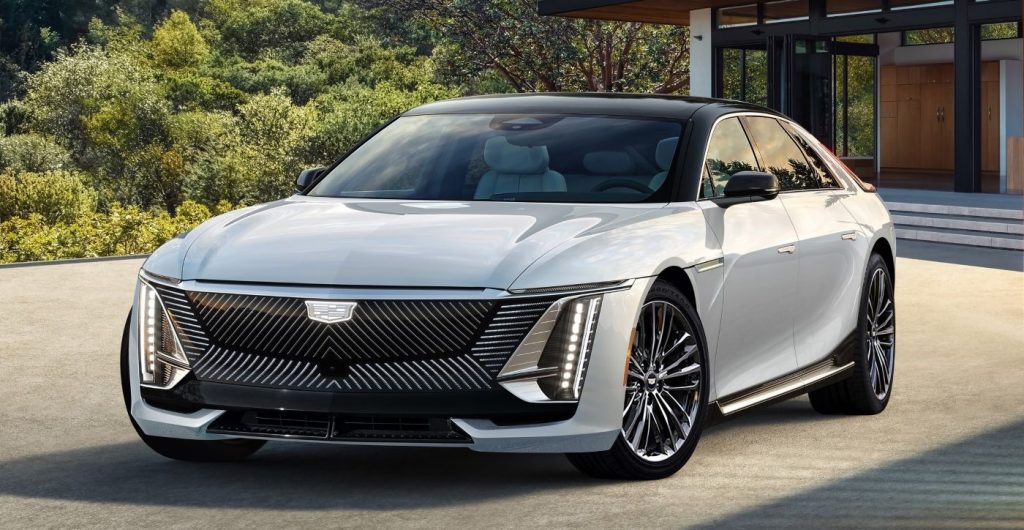
Under the hood, the Celestiq features two electric motors that deliver 600 horsepower and 640 pound-feet of torque, paired with all-wheel drive and direct drive transmission.
The car’s range is expected to be around 300 miles per charge, although actual results may vary. The Celestiq’s high-tech features and premium comfort are designed to appeal to both longtime Cadillac enthusiasts and new customers seeking the latest innovations in luxury electric vehicles.
Mercedes EQS 580
The Mercedes EQS 580 is another powerhouse in the luxury car market, especially with its groundbreaking 56-inch touchscreen. This impressive panel combines two 12.3-inch displays in front of the driver and passenger, along with a 17.7-inch central touchscreen, all behind a single glass surface, creating a seamless “Hyperscreen” design that is as visually striking as it is functional.
The EQS 580 is powered by two electric motors, delivering 516 horsepower and 611 pound-feet of torque. With all-wheel drive and direct drive, it can travel up to 277 miles on a single charge.
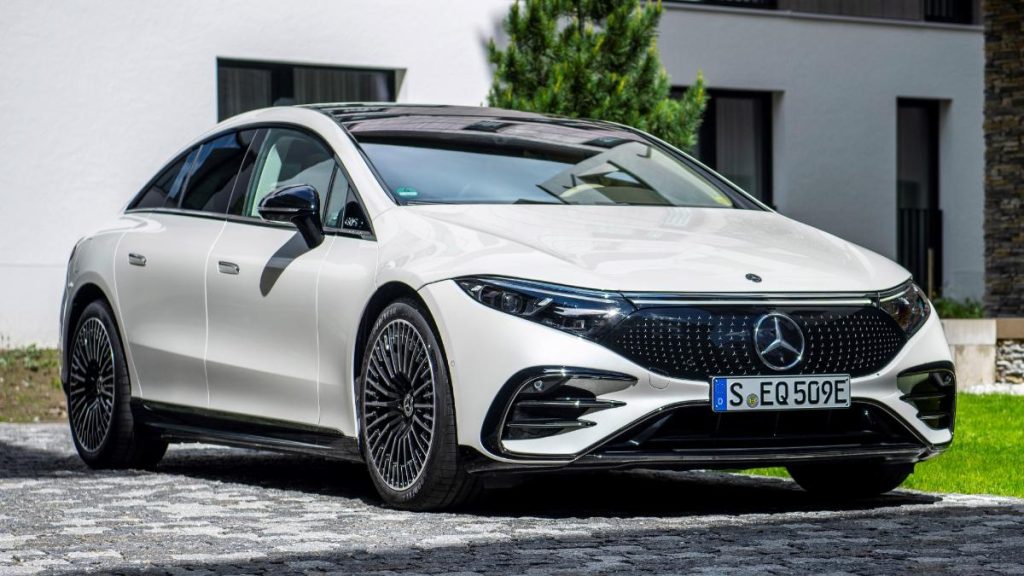
Mercedes-Benz has equipped the EQS with a range of luxurious features, including heated neck and shoulder support, massaging seats, and headrest pillows, making it one of the most comfortable and technologically advanced cars available today.
The luxury and high-tech features of the EQS ensure that it is not only a pleasure to drive but also a luxurious experience for passengers, making it a strong competitor in the world of luxury electric vehicles.

